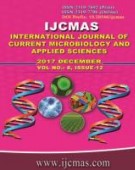


 National Academy of Agricultural Sciences (NAAS)
National Academy of Agricultural Sciences (NAAS)

|
PRINT ISSN : 2319-7692
Online ISSN : 2319-7706 Issues : 12 per year Publisher : Excellent Publishers Email : editorijcmas@gmail.com / submit@ijcmas.com Editor-in-chief: Dr.M.Prakash Index Copernicus ICV 2018: 95.39 NAAS RATING 2020: 5.38 |
Rice is an important food crop which contributes nearly 39per cent to total food grain production in India. The population of our country has increased around 18 crores but production of rice increased by around 10 million tones in last decade. The level of rice production may not be sufficient to feed the ever increasing population in the future. The scope for expansion of area under rice has already been exhausted; the only way to increase the production is by increasing the productivity of rice through frontier technologies. The hybrid rice may be potential technology to increase the average productivity level of rice in the country. Hybrid rice has potential to 20-30 per cent higher production than the inbred rice within same maturity duration as reported in previous studies. But farmers could not be able to realize higher yield of hybrid rice due to poor management practices, incidence of pest and diseases etc. The high seed cost of hybrid seed coupled with unawareness of management practices were restricting farmers for adopting recommended hybrid rice production technology. Thus the subsidy should be provisioned on seeds to reduce its cost for its popularization and promotion among the rice growers. Addition to it, training to the farmers on management practices of hybrid rice cultivation seems to be pre-requisite for successful harvest. Use of fertilizer and plant protection chemicals were found variables in different categories of farms, thus need for conduct demonstration of hybrid rice on farmer’s field and awareness campaign on improved cultivation practices should be done. In this context there is a need to follow a strong extension program in the area regarding improved cultivation practices of hybrid rice. Such knowledge would serve as a guide to policy makers, producers and all those who are interested in increasing and mobilizing its potential and improving efficiency of various functions of production process and which would ultimately benefit the producers.
 |
 |
 |
 |
 |